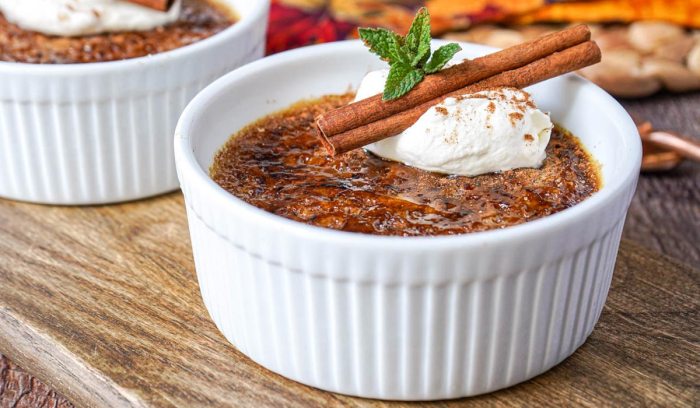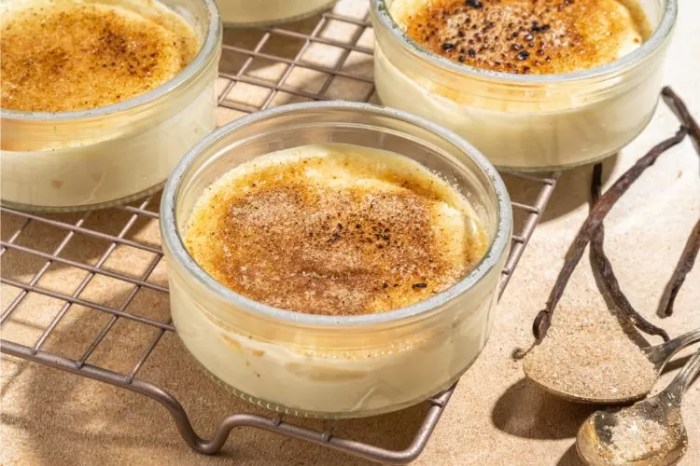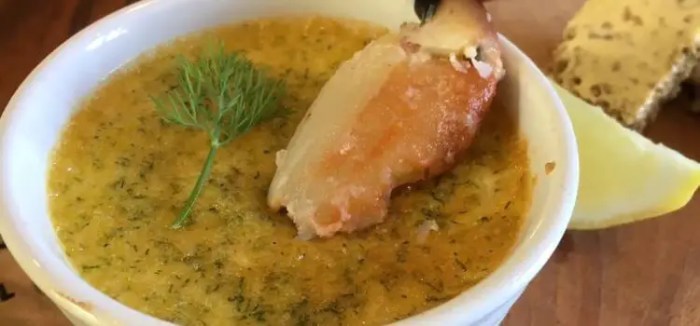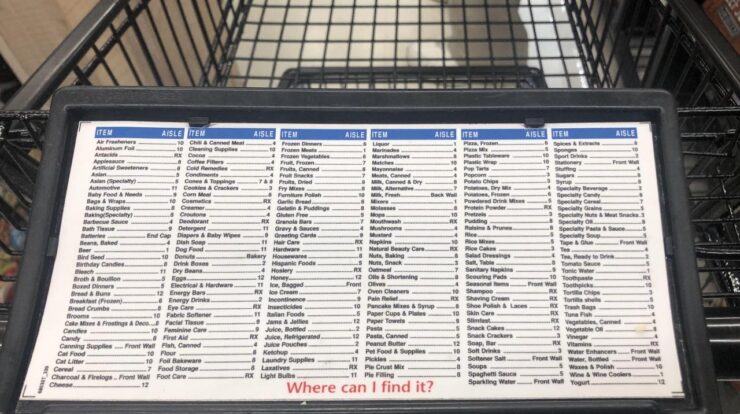
Crab brulee recipe – Prepare to indulge in the extraordinary Crab Brulee, a culinary masterpiece that elevates the classic French dessert with the savory flavors of the sea. This exquisite dish tantalizes taste buds with its rich, creamy texture and the delicate sweetness of succulent crab.
From its humble origins to its modern-day variations, the Crab Brulee has captured the hearts of food enthusiasts worldwide. Join us on a delectable journey as we explore the secrets behind this culinary gem.
Recipe Ingredients and s

Preparing a delectable crab brûlée requires a precise selection of ingredients and careful execution of culinary techniques. Here’s a comprehensive guide to the essential components and step-by-step s for creating this exquisite dish:
Ingredients
- Fresh crabmeat:1 pound, picked and flaked
- Heavy cream:1 cup
- Whole milk:1/2 cup
- Eggs:3 large
- Egg yolks:2 large
- Dijon mustard:1 tablespoon
- Old Bay seasoning:1 teaspoon
- Salt and black pepper:To taste
- Unsalted butter:For greasing the ramekins
- Panko breadcrumbs:For topping
s
- Preheat the oven:Set your oven to 350°F (175°C) to prepare for baking.
- Prepare the ramekins:Grease four 6-ounce ramekins with unsalted butter. Sprinkle panko breadcrumbs evenly over the buttered surfaces to coat.
- Combine the ingredients:In a large bowl, whisk together the heavy cream, milk, eggs, egg yolks, Dijon mustard, Old Bay seasoning, salt, and black pepper.
- Add the crabmeat:Gently fold the flaked crabmeat into the liquid mixture until evenly distributed.
- Pour into ramekins:Divide the crab mixture evenly among the prepared ramekins.
- Bake the brûlées:Place the ramekins in a large baking dish filled with hot water (a water bath). Bake for 30-35 minutes, or until the edges are set and the centers are still slightly wobbly.
- Cool and chill:Remove the ramekins from the water bath and let them cool to room temperature. Then, refrigerate for at least 4 hours or overnight to allow the brûlées to fully set.
- Prepare the topping:In a small bowl, combine panko breadcrumbs, melted butter, and chopped parsley. Season with salt and pepper to taste.
- Torch the tops:Before serving, sprinkle the topping mixture over the chilled brûlées. Using a kitchen torch, caramelize the tops until golden brown and bubbly.
- Serve immediately:Enjoy your delicious crab brûlées while they’re warm and the topping is crispy.
Variations and Substitutions
Experimenting with different ingredients and techniques can enhance the flavor and presentation of your crab brûlée. Consider these variations and substitutions to tailor the recipe to your preferences or dietary needs.
Seafood Variations
- Swap out crabmeat for other seafood options like lobster, shrimp, or scallops.
- Combine different types of seafood for a more complex flavor profile.
Ingredient Substitutions
If you have dietary restrictions or personal preferences, here are some substitutions to consider:
- Use gluten-free flour instead of all-purpose flour for a gluten-free version.
- Substitute heavy cream with a dairy-free alternative like coconut cream or almond milk.
- Omit the egg yolk for a vegan option.
Remember, these variations may slightly alter the flavor or texture of the dish, but they offer opportunities to customize it to your liking.
Flavor Profiles and Pairings: Crab Brulee Recipe

The crab brûlée presents a unique flavor profile that harmoniously blends the delicate sweetness of crab with the richness of a creamy custard. The dominant flavors are the briny, oceanic notes of the crab, complemented by the subtle sweetness of the custard.
Aromatically, the dish exudes a tantalizing fragrance that combines the fresh, seafood scent of crab with the warm, buttery aroma of the custard.
Wine Pairings
To enhance the culinary experience, consider pairing the crab brûlée with suitable wines that complement its flavors. White wines with crisp acidity and a light to medium body, such as Sauvignon Blanc or Pinot Grigio, can provide a refreshing contrast to the richness of the dish.
Alternatively, a light-bodied red wine like Pinot Noir, with its subtle earthy notes, can complement the briny flavors of the crab.
Meal Pairings
The crab brûlée can be incorporated into a balanced meal by pairing it with dishes that offer contrasting textures and flavors. A light and refreshing salad with a citrus vinaigrette dressing can provide a vibrant acidity that cuts through the richness of the custard.
Alternatively, a grilled vegetable platter with a flavorful dipping sauce can offer a healthy and flavorful accompaniment to the dish.
Chicken of the woods, a unique and flavorful mushroom, is a delicious addition to any meal. For a classic preparation, check out this chicken of the woods recipe . Simply sauté the mushrooms in butter and garlic until golden brown, then season with your favorite herbs and spices.
Presentation and Serving Suggestions

To elevate the dining experience, consider the following elegant and creative presentation ideas for your crab brûlée:
Showcase the dish in individual ramekins or cocotte dishes. Arrange them on a serving platter adorned with fresh herbs or edible flowers for a vibrant touch.
Accompaniments and Garnishes
- Serve with a drizzle of lemon-herb butter sauce or aioli to enhance the richness of the crab.
- Top with a delicate salad of mixed greens, shaved fennel, and citrus segments for a refreshing contrast.
- Garnish with crispy shallots or bacon bits for a savory crunch.
Serving Temperature and Portion Sizes
For optimal flavor and texture, serve the crab brûlée warm or at room temperature. As for portion sizes, individual ramekins allow for customizable servings, catering to both small and large appetites.
Origin and History

Crab brûlée is a modern dish that combines the classic French dessert crème brûlée with the rich flavors of crab meat. Its origins can be traced back to the early 2000s, when chefs began experimenting with new and innovative ways to use seafood in fine dining.
The dish quickly gained popularity in upscale restaurants and has since become a staple of modern American cuisine. It is often served as an appetizer or first course, and its elegant presentation and sophisticated flavors have made it a favorite among food enthusiasts.
Cultural Significance
Crab brûlée has no significant cultural significance beyond its culinary appeal. It is not associated with any particular region or culture and is enjoyed by people of all backgrounds.
If you’re looking for a more adventurous twist, try this chicken of the woods recipe . The mushrooms are roasted with onions and bell peppers, then tossed in a tangy sauce made with lemon juice, honey, and Dijon mustard. Serve it over rice or pasta for a satisfying and unforgettable meal.
Regional Variations
There are few regional variations of crab brûlée, as it is a relatively new dish. However, some chefs have experimented with different types of crab meat, such as blue crab, Dungeness crab, and king crab. Others have added additional ingredients to the custard, such as herbs, spices, or vegetables.
Evolution of the Recipe
The recipe for crab brûlée has evolved over time as chefs have experimented with different ingredients and techniques. The original recipe called for a simple custard made with crab meat, cream, eggs, and butter. Over time, chefs have added other ingredients, such as herbs, spices, and vegetables, to create more complex and flavorful variations.
The technique for making crab brûlée has also evolved. The original recipe called for the custard to be baked in a water bath. However, some chefs now prefer to bake the custard directly in the oven, which results in a more caramelized crust.
Anecdotes or Stories, Crab brulee recipe
There are no widely known anecdotes or stories related to the history of crab brûlée.
Last Recap
As we bid farewell to the delectable Crab Brulee, let us savor the memories of its exquisite flavors and innovative presentation. Whether enjoyed as a standalone delicacy or paired with complementary dishes, this culinary creation is a testament to the boundless possibilities of culinary artistry.
May your future culinary adventures be filled with inspiration and the joy of discovering new taste sensations. Until next time, bon appétit!
FAQ Corner
What is the origin of Crab Brulee?
Crab Brulee traces its roots to the classic French dessert, Crème Brulee. However, its seafood variation emerged in modern times, combining the sweet and savory elements of both worlds.
Can I use other types of seafood in this recipe?
Absolutely! Feel free to experiment with different seafood options such as shrimp, lobster, or scallops. Each type of seafood will impart its unique flavor and texture to the dish.
How do I achieve the perfect caramelized crust?
To achieve a golden-brown and crispy caramelized crust, use a kitchen torch to evenly melt the sugar topping. Alternatively, you can place the dish under a preheated broiler for a few minutes, keeping a close eye to prevent burning.





